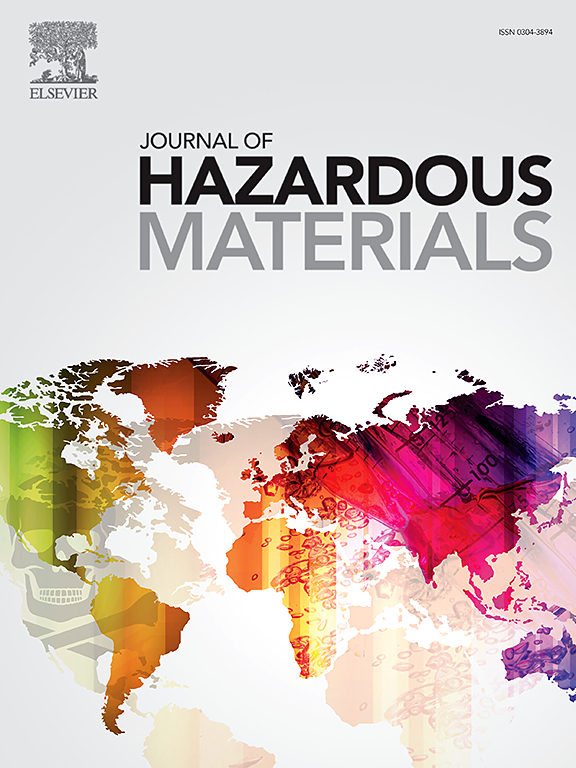IF 12.2
1区 环境科学与生态学
Q1 ENGINEERING, ENVIRONMENTAL
引用次数: 0
摘要
本研究通过动态吸附实验和分子模拟,系统研究了六种脂肪族挥发性有机化合物(环己烷、正己烷、甲基环戊烷、正丁醇、乙酸丁酯和甲基丙烯酸甲酯)在工业USY沸石上的单组分和双组分竞争吸附行为。单组分动态吸附实验结果表明,高极性挥发性有机化合物(正丁醇、乙酸丁酯和甲基丙烯酸甲酯)在 USY-10、USY-40 和 USY-60 沸石上的饱和吸附容量明显高于低极性挥发性有机化合物(环己烷、正己烷和甲基环戊烷)。此外,分子量大、沸点高的高极性挥发性有机化合物在 USY 沸石上的扩散性能弱,吸附能力强。在双组分竞争吸附实验中,高极性 VOC 在 USY-60 上的竞争吸附能力强于低极性 VOC。同时,线性结构分子因其卓越的扩散能力而表现出竞争优势。单组分 DFT 计算结果表明,高极性 VOC 在 USY 沸石上的吸附能(从 -181.29 KJ/mol 到 -140.49 KJ/mol)明显负于低极性 VOC(从 -122.47 KJ/mol 到 -99.07 KJ/mol)。USY-60 上双组分吸附的吸附位点计算表明,高极性 VOC 与 Na⁺ 离子的相互作用更强。双组分竞争吸附的能量计算结果表明,高极性和线性结构的 VOC 在 USY-60 上的相互作用能较低。这项研究为去除工业双组分挥发性有机化合物提供了理论依据和实践指导。本文章由计算机程序翻译,如有差异,请以英文原文为准。

Dynamic adsorption and molecular simulation of aliphatic VOCs on industrial USY zeolites: Two-component competitive behavior
In this study, the single-component and two-component competitive adsorption behaviors of six aliphatic VOCs (cyclohexane, n-hexane, methyl-cyclopentane, n-butanol, butyl-acetate and methyl-methacrylate) on industrial USY zeolites were systematically investigated through dynamic adsorption experiments and molecular simulations. The results of the single-component dynamic adsorption experiments showed that the saturated adsorption capacity of high-polarity VOCs (n-butanol, butyl-acetate and methyl-methacrylate) were significantly higher than low-polarity VOCs (cyclohexane, n-hexane and methyl-cyclopentane) on USY-10, USY-40 and USY-60 zeolites. Furthermore, the high-polarity VOCs with high molecular weights and boiling points had weak diffusion properties and strong adsorption capacity on USY zeolites. In two-component competitive adsorption experiments, the competitive adsorption abilities of high-polarity VOCs exhibited stronger than low-polarity VOCs on USY-60. Meanwhile, linear-structured molecules demonstrated competitive advantages owing to their superior diffusion capabilities. Single-component DFT calculation results showed that the adsorption energy of high-polarity VOCs (from −181.29 KJ/mol to −140.49 KJ/mol) was significantly more negative than low-polarity VOCs (from −122.47 KJ/mol to −99.07 KJ/mol) on USY zeolites. The adsorption site calculations of two-component adsorption on USY-60 indicated that high-polarity VOCs interacted more strongly with Na⁺ ions. The energy calculation results of two-component competitive adsorption indicated that high-polarity and linear-structured VOCs exhibited low interaction energies on USY-60. This study provided theoretical insights and practical guidance for the removal of industrial two-component VOCs.
求助全文
通过发布文献求助,成功后即可免费获取论文全文。
去求助
来源期刊

Journal of Hazardous Materials
工程技术-工程:环境
CiteScore
25.40
自引率
5.90%
发文量
3059
审稿时长
58 days
期刊介绍:
The Journal of Hazardous Materials serves as a global platform for promoting cutting-edge research in the field of Environmental Science and Engineering. Our publication features a wide range of articles, including full-length research papers, review articles, and perspectives, with the aim of enhancing our understanding of the dangers and risks associated with various materials concerning public health and the environment. It is important to note that the term "environmental contaminants" refers specifically to substances that pose hazardous effects through contamination, while excluding those that do not have such impacts on the environment or human health. Moreover, we emphasize the distinction between wastes and hazardous materials in order to provide further clarity on the scope of the journal. We have a keen interest in exploring specific compounds and microbial agents that have adverse effects on the environment.
 求助内容:
求助内容: 应助结果提醒方式:
应助结果提醒方式:


